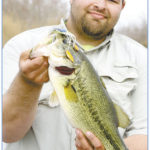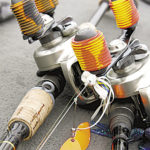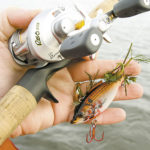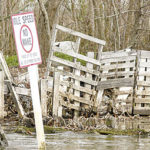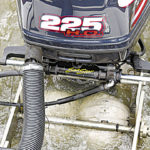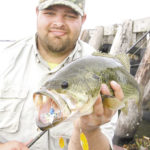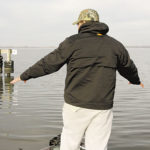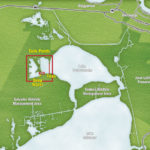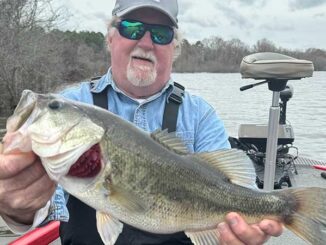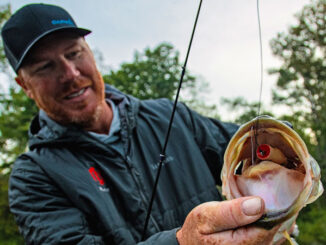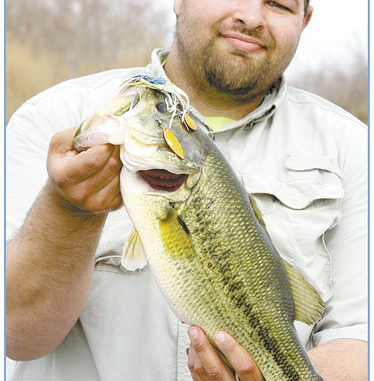
This Grand Point bass angler passes lots of great fishing spots to get to Lake Cataouatche, because the action there is like an irresistible lure to him.
After releasing his third bass of the morning, Matthew Hymel wondered aloud if I had learned my lesson yet. Although we had met for the first time only two hours earlier, he was starting to get a sense of just how hard-headed I can be.
In fact, I didn’t care how many bass he caught on his little homemade spinnerbait; I was perfectly happy throwing my tandem Indiana Mr. Hooty with nickel and gold blades. Being down three to zero didn’t even faze me.
“No way that orange blade on yours is making that much of a difference,” I insisted.
“You know how many nickel and gold spinner blades these bass see every day,” Hymel dug in.
“No,” I answered while pointing at the fluorescent orange tandem blades dangling from his spinnerbait swivel, “but I know how many orange blades they’ve seen today — two, those two.”
I watched the four other boats fishing around us as Hymel continued to sling his little orange-bladed spinnerbait, and the only action I saw was at the end of his rod.
Two more chunky bass that Hymel caught in short order got me to wondering if my pretend learning disability, ADLAS (Attention Deficit, Look A Squirrel), was finally starting to have an actual effect.
“I made two,” he offered.
Squirrels or not, his lesson in slinging orange-bladed spinnerbaits finally found fertile ground. I cut off my Mr. Hooty rather than take the time to change the blades and tied my best palomar knot on the R-bend of the blade Hymel just tossed to me.
The blades dang near blinded me.
Before our trip to Lake Cataouatche, Hymel and I spent several days trying to pinpoint the best day to fish. Planned days fell by the wayside as the weather played with our emotions.
We finally settled on a perfect-looking Saturday that was forecast to have crystal-clear skies, light winds and warming temperatures. All of these variables were in our favor as the water in the Tank Ponds on the western side of Lake Cataouatche ranged from 42 to 50 only two days before.
After making the short run from the Bayou Segnette State Park boat launch, Hymel dropped his trolling motor as he passed through tires and noticed that the water temperature had already improved from the Thursday before.
“The air temperature didn’t go down much last night,” Hymel said. “It stayed around 46.
“I may not have caught anything the other day, but Lake Cataouatche is the kind of place you can zero one day and catch 15 pounds the next. We’ve already got 48 degrees, and if it hits 52 or 53 degrees today, we should be good.”
And as would become obvious to me later, Lake Cataouatche is also one of those kinds of places where it’s nothing to go in there and throw the book out the door.
Although he passes plenty of good fishing places during his hour-long trip from Grand Point to New Orleans, this Grand Point Fishing Club member, who is a self-professed working man and weekend angler, says he heads to Cataouatche because it’s been one of the premiere places to bass fish in all of Louisiana the last few years.
Upon passing the tires, we noticed that there were four or five boats already fishing in the Tank Ponds. None of them concerned Hymel.
“We’re about two or three weeks early,” he said. “When this place turns on in March, it’s nothing to come in here and see 50 or 60 boats all in this one little area. I mean you can literally walk from boat to boat.
“We’re going to work over this flat throwing some spinnerbaits and Red Eye Shads, but our main goal is to get to that bottleneck in the back corner where the deeper water is.”
At 8:24 in the morning, something was already slapping the surface of the water. Hymel said he couldn’t tell if the action was from bass, gar or maybe bait. He was confident bait was in the Tank Ponds because he saw some diving seagulls just two days before.
Because neither of us was getting any bites, Hymel started doing something different beyond fishing with orange blades. Rather than slow roll his blade among all the structure on the hard bottom, he started holding his rod higher and pulling his spinner just inches below the surface.
At least one bass found this change in retrieve to its liking, but he didn’t stay hooked. Even though it was a swing and a miss, Hymel noticed something pretty important: The water temperature had already risen to 50 degrees just 40 minutes into our trip.
Hymel stuck with his orange-bladed spinnerbait as we worked closer to the deeper water, and I changed between my Mr. Hooty spinnerbait, a junebug YUM Dinger and a bleeding-shad Rat-L-Trap. All started gathering grass as the flat got shallower as we got to the ledge that dropped off into the channel.
As he worked through the mouth of the bottleneck, Hymel cast his spinnerbait toward the bank. After cranking the handle just a couple times, he imagined that his lure was at the lip of the drop. He stopped his retrieve just for a couple seconds to allow his bait to flutter off the drop, and our first bass of the day nailed it at 9:36.
“He whacked it,” Hymel grunted as he struggled to try to subdue the bass and lift it out of the water. “That was one aggressive bite. But that’s not unusual even in colder water. It’s 51 degrees in here, and they become very active when it gets into the lower 50s.”
Hymel determined that our key going forward should be to focus on triggering reaction bites by doing something different than just rolling our spinnerbaits back. The bass bit while his blade was fluttering on a pause, so we decided to mix it up by either letting our blades fall on the drop or giving them a little twitch every now and then.
His suspicion was confirmed as another bass slammed his spinnerbait only two minutes after he landed the first one. He stopped reeling when his blade got about 3 feet from the bank, and the bass slammed it as it fluttered down. Only this time, Hymel wasn’t paying attention, and the bass swam free.
We fished our way through the little bottleneck to where it opened up into another expansive flat to the west of the Tank Ponds. A small canal intersected the channel we were fishing, and Hymel made note of a tree in the water that he had never seen before.
“That just shows you how low the water is right now,” he said. “Imagine the water up about a foot and a half, and you can tell you wouldn’t be able to see that tree.
“I’ll make a mental note of that because it’s off this point. Should be able to come back to it one day and pull off some bass with a Sweet Beaver or a Baby Brush Hog.”
As it was, Hymel made a long cast down the edge of the canal to our north. Fish No. 2 bit at 9:45, and was about 2 1/2 pounds. It came off of a tree that had fallen down on the little point of the canal intersection.
“I was just about to stop it by that tree, and he caught it,” Hymel said. “He caught it on the go, too. This one didn’t wait for me to stop it. He slammed it just like the first one — no little come up and nip it. I think the key, other than doing something different with our baits, has so far been fishing closer to this deeper water.”
By 10:17, the water had jumped to 52 degrees, and Hymel thought the bite just might be ready to really turn on. He cast beside the tree that he had pointed out earlier, and we could see the wake of a bass plowing forward to crush Hymel’s orange-bladed spinnerbait.
Hymel assessed our plan while unhooking his third bass. He decided that we would stick with this same spot to see if we could get two more, which would put us at a five-bass limit even though we weren’t fishing a tournament.
“Our game plan is to work the shallow flats and ledges all around this intersection,” he announced. “We’ve caught some on the little drop and one out on the flats, so we’ll fan cast all four corners, hit that little island, and see what we can do.
“We’ve got about 8 pounds with three fish. Hopefully we can get one of those big girls to bite. And if you’ve learned anything by now, it ought to be to tie on this other orange-bladed spinnerbait I made for you last night.”
I followed directions while watching Hymel add a fourth bass at 10:23 and a fifth at 10:31. Maybe there was more to what he was doing than just throwing orange blades.
Three minutes later, this blind hog found his acorn.
With six bass on the tally sheet, Hymel decided to troll back through the Tank Ponds to look for a kicker. He hooked two good bass on an XCalibur One Knocker lipless crankbait. They slammed his lure but wound up tangling in unseen obstructions under the water. We actually watched 4- and 5-pound bass jumping out of the water around us, but we got no more bites.
After wrapping up our day in a little canal to the north of Lake Cataouatche that was lined with boat docks, Hymel reflected on our trip.
“We did a lot better than I thought we would,” he said. “The clouds never really broke, but that didn’t keep the water temperature from rising.
“The warmest it got was 55 degrees. I think on a day like this, the thing I learned was to do something different and to stick with it if it’s working.”
For us, the “something different” was the orange spinner blades. Everybody around us was punching dead water hyacinths and throwing nickel and gold spinner blades to no avail.
I wonder what they would have paid for a couple of those orange blades. You know they’re going to cost a lot more on the water than they did in Z’s Tackle Shop back in Lutcher where Hymel bought them.
Thank goodness he didn’t charge me. My pockets aren’t that deep.
